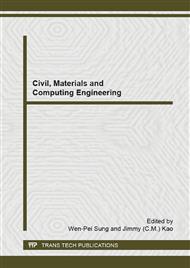p.547
p.553
p.558
p.562
p.566
p.574
p.579
p.584
p.591
A Study about Security of Wind Turbine Foundation in Different Width and Height Ratios
Abstract:
Width and height ratio is a characteristic geometry feature of wind turbine foundations. This study establishes the relationship between security of wind turbine foundations and their width and height ratios. There are a number of works on checking wind turbines, however, limited works about how the width and height ratio influences the structure were conducted. This paper provides fifteen models of three different shapes, five circular foundations, five hexagon foundations and five triangle foundations. Data from a wind farm in Guizhou, China, is used to calculate the main wind loads acted on wind turbine structures. Then key factors concerning with security of foundations were obtained. And they were put together so that it is easy for us to find their relationships. The results show foundations have different performance at different ratios. It’s change laws were so clear, security of foundations is improved by the increasing of width and height ratio. On the other hand, hexagon and triangle foundations were certificated suitable for general projects.
Info:
Periodical:
Pages:
566-573
Citation:
Online since:
December 2014
Authors:
Keywords:
Price:
Сopyright:
© 2015 Trans Tech Publications Ltd. All Rights Reserved
Share:
Citation:


